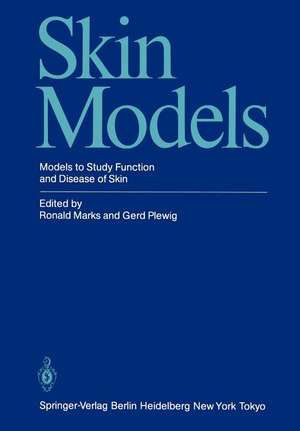Skin Models: Models to Study Function and Disease of Skin
Editat de Ronald Marks, Gerd Plewigen Limba Engleză Paperback – 16 noi 2011
Preț: 728.52 lei
Preț vechi: 766.87 lei
-5% Nou
Puncte Express: 1093
Preț estimativ în valută:
139.40€ • 145.94$ • 115.35£
139.40€ • 145.94$ • 115.35£
Carte tipărită la comandă
Livrare economică 07-21 aprilie
Preluare comenzi: 021 569.72.76
Specificații
ISBN-13: 9783642703898
ISBN-10: 3642703895
Pagini: 464
Ilustrații: XXII, 438 p.
Dimensiuni: 170 x 244 x 24 mm
Greutate: 0.74 kg
Ediția:Softcover reprint of the original 1st ed. 1986
Editura: Springer Berlin, Heidelberg
Colecția Springer
Locul publicării:Berlin, Heidelberg, Germany
ISBN-10: 3642703895
Pagini: 464
Ilustrații: XXII, 438 p.
Dimensiuni: 170 x 244 x 24 mm
Greutate: 0.74 kg
Ediția:Softcover reprint of the original 1st ed. 1986
Editura: Springer Berlin, Heidelberg
Colecția Springer
Locul publicării:Berlin, Heidelberg, Germany
Public țintă
ResearchDescriere
In the last fifty years dramatic progress has been made in the under standing of skin and skin diseases. Although we are still someway off understanding the ultimate causes of such disorders as psoriasis, atopic dermatitis and the congenital disorder of keratinization, we now have considerable information on the physiological disturbances in various diseases. This has permitted and encouraged a rational approach to treatment. The successful use of antimitotic agents, immunomodulators and retinoids may be cited as examples. A major reason for this im provement may be the fact that researchers accept models for the in vestigation of skin diseases. Increasing numbers of them have become available in the past years. So many have been described that it is doubtful whether anyone researcher is aware of all the other models described - even in his own field of interest. This book is a challenge for those involved in the study of skin and its disorders to use the sundry models of skin that have proven helpful. It would be impossible for this work to be all-embracing but it is hoped that the choice of models offered in this publication will be stimulating and helpful in the solution of knotty skin questions. April,1986 Ronald Marks, Cardiff Gerd Plewig, DUsseldorf Table of Contents In Vivo Models Human Model for Acne . . . . . . . . . . . . . . . . . . . . . . . . . . . 2 L. C Brummitt, W. J. Cunliffe, G. Gowland Models to Study Follicular Diseases l3 G. Plewig Models for Wound Healing. . . . . . . . . . . . . . . . . . . . . . . . . 24 R. Marks, D. Williams, A. D.
Cuprins
In Vivo Models.- Human Model for Acne.- Models to Study Follicular Diseases.- Models for Wound Healing.- Sunscreen Evaluation by Mouse Spectrophotometric and Human Assays.- The Rhino Mouse: Retinoid Effects on a Model of Keratin Accumulation.- Further Studies with Models for the Transepidermal Elimination Process.- Induction of Cutaneous Melanocytic Tumours by N-Ethyl-N-Nitrosourea in the Mongolian Gerbil (Meriones Unguiculatus).- Amphibian Skin as a Model in Studies on Epidermal Homeostasis.- Transplantation Studies on Solar Keratoses in Nude Mice.- Modelling for the Inflammation of Acne.- New Models for Testing Skin Toxicity.- Human Cutaneous Pharmacokinetics In Vivo.- The Vasoconstrictor Test as a Model for Developing Topical Formulations.- Skin Models in the Understanding of the Physiological and Pathological Properties of Collagen.- Applications of the Diazacholesterol Animal Model of Ichthyosis.- The Transcutaneous Oxygen Pressure (tcPO2) as a Non-Invasive Measurement of Aerobic Skin Metabolism and Skin Permeability in Psoriasis.- Experimental Contact Dermatitis Using 2,4-Dinitrochlorobenzene in Humans.- In-Vivo-UVA-Tests: Erythema, Pigmentation, Phototoxicity.- Thermography as a Model for Cutaneous Vascular Responses.- The Long-Haired Syrian Hamster: An Animal Model for Androgen Induced Hair Growth.- Biochemical Markers in the Mouse Tail Model of Psoriasis.- Corneocyte Exfoliative Cytology: A Model to Study Normal and Diseased Stratum Corneum.- Modulation of EGF Receptors during Epidermal Hyperplasia.- Comparative Study of the Keratin Polypeptide Profiles in Human and in Pig Hyperkarotic Scabies.- In Vitro Models.- Role of Extracellular Matrix in Skin Morphogenesis, Analysed by Dermal Cell Cultures.- The Development of Epidermis In Vitro. Electronmicroscopic and Autoradiographic Studies in the Limb Bud Culture.- In Vitro Perfusion of Human Skin.- The Use of Human Scalp and Abdominal Skin as In Vitro Models for Percutaneous Absorption.- An In Vitro Human Skin Model for Assaying Topical Drugs against Dermatophytic Fungi.- In Vitro Models for Cutaneous Phototoxicity.- HET (Hen’s Egg Test) in Toxicological Research.- Use of Uninvolved Psoriatic Epidermis as an In Vitro Model for Testing the Anti-Phospholipase Activity of Glucocorticoids.- Skin Fibroblast Monolayers: A Suitable Case for Treatment?.- Model for Biochemical Studies on the Mechanisms Underlying the Regulation of Cholesterol Synthesis.- A Model for Morphological Studies on Ligand-Receptor Complexes.- Use of In Vivo and In Vitro Test Systems as Predictors of the Cutaneous Irritancy of Synthetic Detergents (Syndets).- Lectin Induction of Pemphigus and Phemphigoid-Like Bullae in Organ Cultured Human Skin.- On the Non-Random Distribution of Dividing Cells.- High Doses of Antigen-Nonspecific IgG do not Inhibit Pemphigus Acantholysis in Skin Organ Cultures.- Permeation of Drugs through Human Skin: Method and Design of Diffusion Cells for In Vitro Use.- Mathematical and Physical Models.- Modelling the Scattering and Absorption of Light by the Skin.- Mathematical Models for the Ultraviolet Optics of Human Epidermis.- Simulation of Diffusion in Skin.- An Interactive Computer Model as a Laboratory Tool for Research on Epidermal Cellular Interactions.- Sound Skin Models — Acoustic Properties of Epidermis and Dermis.- In Vitro Test Systems for Evaluation of the Physical Properties of the Skin.- The Use of Statistical Models Employing Analysis of Variance for Efficient Analysis of Data.














